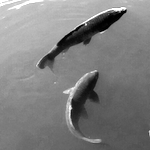While many aquatic animals swim close to or at the water surface, few studies have considered the impact of the surface on locomotion. For example, postural stability is often taken for granted, whereas it can be very precarious at the water surface. Also, its impact on navigation or swimming efficiency can be dramatic.
Do slender swimmers naturally stabilise at the surface or do they use elaborate strategies to maintain their balance? This is the question that our presentation will answer.
We will first present some observations of snakes swimming on the water surface. These observations show that swimming is almost innate, independently of energetic efficiency, even for non-aquatic species living in desert areas. In contrast, we observe that some snakes need to constantly correct their poses while semi-aquatic snakes such as cottonmouths, have an exceptional sense of balance.
In order to better understand the challenges of stability on surface, we propose to develop stabilisation algorithms. More precisely, we aim at producing active strategies of stabilisation based on a new NATRIX robot developed over the last 3 years in our team. A postural stability system is proposed integrating a predictive open loop and a closed loop regulating the stability. The open loop allows the rapid calculation of a sequences of stable stances on the water surface. The closed loop allows to reject perturbations on the body balance and to dampen non-linear oscillations at the water surface by absorbing them by the actuators. These algorithms will be tested and validated on our non-linear simulator.
We will conclude this presentation on the implementation of these algorithms and its coupling with swimming.

 PDF version
PDF version
